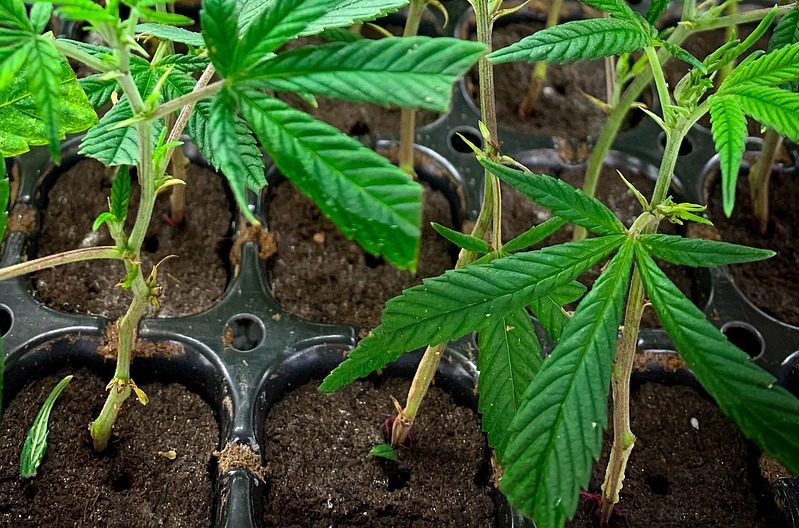There are two ways to know how to tell if clones are rooting. Nowadays, it’s not surprising that many gardeners create cannabis plants through asexual reproduction. It may sound complicated when you hear the word cloning, but this simply pertains to using a cutting from a parent plant.
With cloning, you can ensure that what you’ll harvest are exact copies of your best plants traditionally or using a machine. If you have a parent plant with excellent characteristics, cloning is the best method for reproducing cannabis. However, you must also know if the clones are rooting to do the necessary practices correctly.

Test #1. Tugging
The first and perhaps the most straightforward way to know if your clones have developed roots is tugging them gently. Do this in an upward motion with slight force, and you should feel some firmness to indicate rooting. Be careful in doing this test too early because you don’t want to damage the roots and kill the clones.
Test #2. Check for new growth
Another way to check for rooting is waiting for your clones to develop new growth. Remember that tugging can be risky, so growers often wait for new growth instead. More so, be familiar that rooting can take somewhere between 7 to 14 days, so only expect the holding on the soil or new growth around these periods.
You should also expect your clones not to wilt even though you stopped misting if they formed roots. But again, this test is risky and can kill your clones. Overall, you should find what test works for you based on experience and mark your calendar when you should expect roots.
Why Are Your Clones Not Rooting?
You can feel more at ease with your clones if you ensure that you have done the proper maintenance and practices to encourage their root development. This includes knowing what can prevent them from rooting as well. More so, you are probably neglecting some techniques that affect the rooting of your clones.
Mistakes in taking and preparing cuttings
For example, you must take cuttings that are long enough for burying and spraying. It would help if you cut them at a 45-degree angle to prevent them from getting blocked up. Remove some of the leaves and dip them in rooting hormone before planting.
Mistakes in the environment and medium for rooting
Second, the environment for the cuttings might not be supportive of root growth. The greenhouse is an excellent way to ensure that you can provide an environment with 90% humidity to encourage rooting. Don’t forget to use a moist medium that is influential for root development.
Growers typically use rockwool as their rooting medium because of its moisture retention. This makes it easy to ensure that the cuttings don’t stay somewhere dry that can kill them. If you use rockwool, you don’t need to water often, and you can expect rooting after ten days.
Mistakes in maintenance
Moisture is crucial for encouraging rooting of clones. However, improper watering is also problematic. You want to spray the bottom of the leaves to avoid the development of fungal diseases. Remember that if the top of the leaves doesn’t dry out, you risk developing fungal growth.
More so, check the environment where you’re keeping the clones. Extreme heat or cold can damage and kill the roots. And if you’re using a propagator, dry the condensation inside and at the bottom.
How To Clone Cannabis Plants
Step #1. Choosing the medium and setup
To further ensure that your clones will root, choose the suitable rooting medium and setup. You can use machines that will do most of the work for you compared to traditional setups. Otherwise, use the proper environment and add the necessary equipment such as a humidity dome and heat mat.
Step #2. Taking and rooting cuttings
You then want to use a healthy parent plant that is two months into the vegetative cycle to ensure that it can withstand the cutting. You can also prepare it by stopping fertilizing on the days before you want to take cuttings. This way, you don’t risk having the clones diverting their energy in growing vegetation from the excess of nitrogen.
Select branches with at least two nodes and have no signs of any damage. Use a sharp and sterile tool at a 45-degree angle to increase the rooting surface area. Place the cutting in rooting hormone and into the root cube or cloning machine.
Step #3. Maintenance and transplanting
As mentioned earlier, you want to check your clones’ moisture every day to encourage root development. You can also mist the leaves and continuously check for those with mold to remove them immediately. You can expect transplanting in 10 days, depending on the roots.
Conclusion
Cloning cannabis plants is an excellent way to produce the same copies of your quality strains. However, you should know how to tell if clones are rooting to do the ideal practices in your production management. You can test for roots by gently tugging your clones upward or by checking for new growth.
Remember that root development can take between 7 to 14 days, so be careful in doing tests that can potentially damage your clones. Rooting clones is not something to be intimidated by, and so is checking for cuttings. Over time, you’ll gain experience with your practices, and you’ll know how to check your clones by instinct.

I broke an entire cola that has blooms. How can I save.this as a clone or continue with the flowering stage?